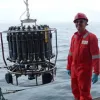
RRS James Cook in transit to the South Sandwich Islands
We have finished our work in the Bransfield Strait and now have a three day passage to our next working area near the southern most South Sandwich Island, Thule.
Our route takes us north-east past Gibbs, Elephant and Clarence Islands on a beautiful sunny…

The Axe, Bransfield Strait
Our final site within the Strait is aptly named ‘The Axe’. This is the least studied site that we have chosen to study and first we need to map the seafloor.
Again we use the conductivity-temperature-depth package to identify anomalous chemical signals in the deep water over the volcanic ridge.…

Three Sisters, Bransfield Strait
We have spent the weekend surveying our second volcanic target in Bransfield Strait: the Middle of the Three Sisters. Again we use the plume sniffing approach followed by video surveys of the seafloor before choosing our coring sites.
…

Mud sampling: 28 January 2011
Alfred Aquilina and the sediment sampling team have been working hard in the cold temperature lab to extract water from the stinking mud from around the hydrothermal sites. “The most exciting thing is to see the data that we process on board” says Alfred, “we are really productive at sea; working…

Pinpointing the Vents: 25 January 2011
By Wednesday we have criss-crossed the seafloor with our towed video sled and have mapped out the animal and substrate distribution on the seafloor. The shimmering water, chimneys and areas of hydrothermal mineralization are all clustered near the top of Hook Ridge.
…

Coring the seafloor: 23 January 2011
Sunday starts with a steam to a new position nearer to the Antarctic Peninsula where we have chosen a site to core the seafloor. Overnight we homed in on the chemical anomalies in the water column that tell us where the vent and seep sites are on the seafloor.
…

Day 3 – Monday 17 January 2011 – Crossing Drake Passage
Monday and we are out in the Drake Passage: a strong head wind slowing us slightly. Drake Passage, between Cape Horn at the tip of Chile and the Antarctica Peninsular, is a choke point for the Antarctic Circumpolar Current that travels around the continent of Antarctica.…

Day 1 – Saturday 15 January 2011 – Crossing Drake Passage
We wake on Saturday morning having navigated the Magellan Straits and now we start to cross the Drake Passage to Antarctica. Paul Tyler is in charge of this expedition and we have a busy schedule ahead of us.
Paul has been going to sea as a scientist since he was…

We are here to carry out a 41 day expedition in the Southern Ocean to explore the newly discovered hydrothermal vents in this remote region. Our principal scientist or expedition leader is Paul Tyler from the University of Southampton who has vast amounts of experience of working in this hostile environment.
…

Last month the RRS James Clark Ross set sail in the direction of the Antarctic Peninsula and the Northern Weddell Sea to measure the production of Antarctic Bottom Water. Onboard ship is an international team of young scientists who are contributing to a blog diary about their work and experiences during the expedition.
…